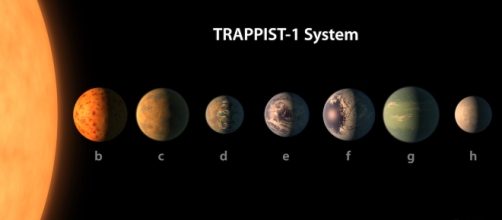Data from NASA/ESA’s Hubble Space Telescope detected what could be the first hint of Water on Trappist-1. Trappist-1 is a dwarf star with seven Earth-sized planets. Scientists believe that the outer planets in the system might have huge amounts of water on them, making them potentially habitable.
The neighboring star system is located at roughly 40 light-years away. The possibility of the outer planets having water was predicted on Feb. 22, 2017. Aside from possibly having water, the Trappist-1 system is also known because it is the nearest star system with the greatest number of Earth-sized planets
Detecting water
Ultraviolet radiation from planets plays a big role in this detecting the presence of water.
Vincent Bourrier of the Observatoire de l’Université de Genève led the study. They used the Space Telescope Imaging Spectrograph (STIS) inside the Hubble Space telescope to analyze the ultraviolet radiation coming from all the seven planets in the star system.
According to Bourrier, ultraviolet radiation is important in order to understand the evolution of planets. On Earth, ultraviolet sunlight breaks molecules while in the atmosphere of exoplanets in Trappist-1 it breaks water vapor into oxygen and hydrogen. Hydrogen gas escapes from the exoplanet’s atmosphere. The gas that serves as an indicator of atmospheric water vapor can be detected by astronomers using the Hubble Space Telescope. The presence of escaped atmospheric gas could be an indicator that water still exists on the Earth-sized exoplanets in the star system.
Due to the amount of ultraviolet radiation, scientists assumed that the exoplanets could have lost a large amount of water through time. Based on their observation, water loss is more dominant in the two innermost planets called Trappist-1b and Trappist-1c. This is because the two receive the highest amount of ultraviolet radiation from the Sun.
Habitable zone
Based on the estimate of the astronomers, the inner planets could have already lost about 20 times the water on Earth in the last eight billion years. But the outer most planets namely Trappist-1e, Trappist-1f and Trappist 1g are inside the “Habitable zone”. It is the area receiving just enough sunlight to allow liquid water to exist. Exoplanets found within the zone are considered as potentially habitable planets due to their possible water content.
This means that the outermost planets may have retained water on their surfaces. With the ultraviolet radiation and calculated water loss included, the outermost planets are still presumed to have flowing liquid water.
Despite the positive result of the investigation, there is no conclusive evidence yet that says there is still water on Trappist-1. Telescopes are not enough to gather data, therefore, additional investigations using more advanced equipment is necessary to conclude for a fact that water still exists on the said star system.


